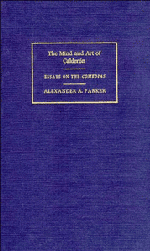Book contents
- Frontmatter
- Contents
- Author's preface
- Editor's preface
- Introduction
- I Stylistic and dramatic craftsmanship
- II From experience to myth
- III The tensions of social life
- 11 The functions of comedy
- 12 The vicissitudes of secrecy (1): La dama duende, El galán fantasma
- 13 The vicissitudes of secrecy (2): El astrólogo fingido
- 14 Secret betrothals and secret marriages: El postrer duelo de España
- 15 From comedy to tragedy: No hay cosa como callar
- 16 A Calderonian conception of tragedy: El pintor de su deshonra
- 17 The tragedy of honour: El médico de su honra
- IV The tensions of public life
- V From symbol to myth
- Epilogue
- Notes
- Index
15 - From comedy to tragedy: No hay cosa como callar
Published online by Cambridge University Press: 05 February 2012
- Frontmatter
- Contents
- Author's preface
- Editor's preface
- Introduction
- I Stylistic and dramatic craftsmanship
- II From experience to myth
- III The tensions of social life
- 11 The functions of comedy
- 12 The vicissitudes of secrecy (1): La dama duende, El galán fantasma
- 13 The vicissitudes of secrecy (2): El astrólogo fingido
- 14 Secret betrothals and secret marriages: El postrer duelo de España
- 15 From comedy to tragedy: No hay cosa como callar
- 16 A Calderonian conception of tragedy: El pintor de su deshonra
- 17 The tragedy of honour: El médico de su honra
- IV The tensions of public life
- V From symbol to myth
- Epilogue
- Notes
- Index
Summary
El postrer duelo de España is a comedy in its structure, but not in its tone; it deals with duelling and with the intrigues that give rise to duelling. It is akin to a cloak-and-sword play in plot and in the atmosphere of social life, but there is no element of comedy in the way the intrigue develops and in the tone of the dialogue. To celebrate the end of public duelling in Spain was a supremely serious aim, one fully in keeping with the solemnity of a court spectacle. The passage from humour to seriousness within the plot conventions of the comedy of intrigue had been made much earlier by Calderón. Comedy with a light humorous tone and a witty development of intrigue is characteristic particularly of his early period. The comedies so far considered all date from the end of the 1620s into the early 1630s. In this latter decade liveliness of stage movement and entertaining intrigues give way to plays that are comedies in structure and convention, but that have a serious subject-matter that uncovers human weakness and the social customs that give them free rein; but this does not become a satire in a didactic or moralistic sense. These are plays that pull back the curtain on human imperfection to enable the audience to see themselves in this light. In practically every comedy of intrigue a point is reached in the climax (near the beginning of Act III) when the action can easily turn to tragedy.
- Type
- Chapter
- Information
- The Mind and Art of CalderónEssays on the Comedias, pp. 181 - 195Publisher: Cambridge University PressPrint publication year: 1989

